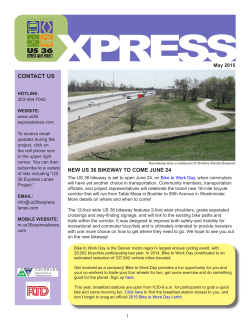
View Brochure
EDC Exchange for Local and Tribal Agencies: EDC-3’s Road Diets April 9, 2015 from 1:00 pm to 3:00 pm Central Standard Time Four-lane undivided highways have a history of relatively high crash rates as traffic volumes increase and as the inside lane is shared by higher-speed through traffic and slowing-or-stopping left-turning vehicles. These types of roadways can experience the following crash types as traffic volumes increase, including: Rear-end and sideswipe crashes caused by speed differential between vehicles; Sideswipe crashes caused by frequent and sudden lane changing between two through lanes; Rear-end crashes caused by left-turning vehicles stopped in the inside travel lane; Left-turn crashes caused by left-turning motorists who feel pressure and make a poor gap judgment to depart the through lane Angle crashes caused by side street traffic crossing four lanes to cross an intersection, or turning left across two lanes; Bicycle crashes due to a lack of available space for bicyclists to ride comfortably; and Pedestrian crashes due to the high number of lanes for pedestrians to cross with no refuge. One option for addressing this safety concern is a Road Diet. The most common Road Diet configuration converts an existing four-lane undivided roadway segment to a three-lane segment consisting of two through lanes and a center two-way left-turn lane (TWLTL). The reduction of lanes allows the roadway cross section to be reallocated for other uses such as bike lanes, pedestrian refuge islands, transit stops, or parking. A Road Diet can be a low-cost safety solution because it can usually be installed within the existing cross section of the roadway, and in many cases only pavement marking modifications are required to make the change. In other cases, the Road Diet may be planned in conjunction with reconstruction or simple overlay projects, and the change in cross section allocation can be incorporated at no additional cost. Geometric and operational design features should be considered during the design of a Road Diet. Intersection turn lanes, traffic volume, signing, pavement markings, driveway density, transit routes and stops, and pedestrian and bicyclist facilities should be carefully considered and appropriately applied during the reconfiguration for appropriate Road Diet implementation. As with any roadway treatment, determining whether a Road Diet is the most appropriate alternative in a given situation requires data analysis and engineering judgment. Once installed, it is important to monitor the safety and operational effects of the corridor, and to make changes as necessary to maintain acceptable traffic flow and safety performance for all road users. Evaluation of Road Diets will provide practitioners the information needed to continue implementing reconfiguration projects in their jurisdictions. Hosted by the FHWA, the Alabama Local Technical Assistance Center Program and the Alabama Department of Transportation at these locations: Central Office, Conference Room 8 1409 Coliseum Boulevard Montgomery, AL 36130-3050 North Region-Guntersville Area (Previously 1st Division), Auditorium 23445 Highway 431 North, Guntersville, AL Second Division 295 Highway 20, East Tuscumbia, AL 35674 Southwest Region-Mobile 1701 North Beltline Highway Mobile, Alabama 36618 Birmingham Two Perimeter Park South, Suite 500 East, Birmingham, AL 35243; (205) 940-6420 Register online: http://www.eng.auburn.edu/online/distance‐education/online‐orders.html PLEASE CONTACT LARRY SELLERS or GARRY HAVRON WITH ANY QUESTIONS: Office 334‐844‐4370; Direct Line 334‐844‐5714; Toll‐free 800‐446‐0382
© Copyright 2025












